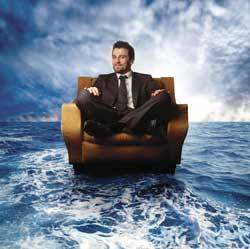Armchair travel no doubt began before there were either armchairs or travel, as we think of them today. The practice may have started as soon as people could communicate well enough to describe what lay on the other side of a mountain or a sea. It grew whenever an account rendered firsthand was retold by someone who remembered it and perhaps embellished what had been said; that teller traveled back on the road of imagination and language to a place he or she had never been, and took another listener there.
It seems that ever since the first couple was pushed out of Eden, humans have longed not only to regain paradise but to explore whatever lies beyond the boundary at hand. Wanderlust may be an attribute scientists will one day declare as hard-wired into the species.
Why “travel in place” embraced by an armchair today, when the world has shrunk and transportation is pervasive? Common reasons include financial constraints, reluctance to travel alone, distaste for crowds or flying, or worries about personal safety (which could be related to flying, or maybe one’s destination country is being bombed just now). Maybe one suffers a physical impediment, temporary or permanent, or maybe timing is the issue: one cannot physically go yet, but wishes to prepare for a future trip. Or one might want to delve into a place from home that one has visited only briefly. Or perhaps one went to a place years ago and wishes to become reacquainted, to see how it, and oneself, have changed. Maybe one loves a place and goes there often, but can never get enough of it. It might even be that one wishes to see one’s own hometown or city with fresh eyes and without taking leave of it. Admittedly, armchair travel is not “the real thing” and cannot fully substitute for it. But it helps one prepare for travels and savor them, and it takes one to many places where an armchair is the only available vehicle.
If the mere titles of the following books start your mental juices flowing—A Land So Strange: The Epic Journey of Cabeza de Vaca, London (the novel) or Paris: The Secret History—then you may have the makings of an armchair traveler. Colin Fletcher’s classic, The Complete Walker, was an early influence in my case. (All these books are worth reading.)
Observation and Imagination
The distinction between direct observation of other places and populations that has been handed down or recorded and imagining them is a thin one. As every armchair traveler knows, the distinction is sometimes impossible to make. Consider two examples from history.
Great Princes, Emperors, and Kings…and People of all degrees who desire to get knowledge of the various races of mankind and of the diversities of the sundry regions of the World, take this Book.... For ye shall find therein all kinds of wonderful things...according to the description of Messer Marco Polo, a wise and noble citizen of Venice, as he saw them with his own eyes.… We shall set down things seen as seen, and things heard as heard only, so that no jot of falsehood may mar the truth of our Book, and that all who shall read it or hear it read may put full faith in the truth of all its contents.
The Description of the World (also known as The Travels of Marco Polo) by Marco Polo (1254-1324), a son in a family of traders, was dictated by the author while he served a yearlong prison sentence. He had come back to Italy and been captured in battle. Polo claimed to be telling what he had seen during years in China and the Mongol Empire, and his bo ok about life under the rule of Kublai Khan proved a sensation during the Middle Ages. But readers at the time considered it fiction. And Polo’s veracity is still being debated today. Even so, the book introduced Europeans to a great Asian culture vastly different from their own. (You can read it and many other copyright-expired books online at Project Gutenberg, but note that the text does not begin until page 216, after copious notes.)
The second example is a diary written by Egeria (381-84), a Spanish nun on pilgrimage to Jerusalem. It describes what Christians did during the Holy Week she spent there: they re-enacted the events of Jesus’ life and Passion, beginning with a palm-waving procession into the city. Her account contributed to the spread of these customs to Spain by the fifth century and to their eventual spread through Europe. Most recently, her account (our oldest record) contributed to the revised Holy Week liturgy. Like many ancient sources, Egeria’s travelogue is fragmentary and the history surrounding it uncertain. A scholar discovered a diary segment at a residence of the Brotherhood of Arezzo in 1887; then scholars put it together with a very similar name mentioned in a seventh-century source about a fourth-century nun whose pilgrimage diary during Holy Week in Jerusalem had been known for centuries. It is thought to be the same writer. Apparently, Egeria was an educated, affluent convert to Christianity, a nun away from her cloister on pilgrimage for several years. She was also a keen communicator, whose travel writings reached not just her sisters in Spain but generations across millennia. (For an online sample of Egeria’s travel diary, go to www.christusrex.net/www1/jhs/TSeger04. html).
Many people would do well to begin with an easy, accessible genre called “travel writing” by most bookstores. “Travelers’ Tales” guides, for instance, is a series of books, each volume of which is focused on a particular country or city popular with tourists. The “tales” are actually “true stories” written by a diverse group of travelers who write well—they are not typical travel writers—and reflect on both customary and very offbeat places. The broad range of writers and the coverage of multiple regions within a country afford a satisfying overview. Such books can be read and reread, which also makes them a good investment, whether one stays home or ventures far.
What about the accounts of imaginary places described in great literature, which also beckon an armchair traveler? Whoever Homer may have been, The Odyssey, his epic poem, still astounds us as a trip worth taking, and no airplane or cruise ship can take us there. Or co nsider other classic destinations like Thomas More’s Utopia, Swift’s Lilliput, Carroll’s Wonderland (or did that belong to Alice?) or Dante’s trips to Purgatory and Hell. Who can challenge the accuracy of such travelogues? Of course the real question is, where do you want to go?
One need not travel far. Anyone can swing by Faulkner’s Yoknapatawpha County and get to know its residents at any time. That also holds true for time travel into the future (science fiction) as well as into the past.
Historical novels, like Sigrid Undset’s Kristin Lavransdatter, all three volumes of which I read while preparing for a trip to Norway, allow for an immersion in Norway’s past. If you go this route, may I suggest the Tiina Nunnally translation for its beauty and modern English.
Novelists like E. M. Forster (1879-1970) have traveled widely. Forster used his experiences and his literary imagination to transport readers to Italy (A Room With a View), England (Howard’s End) and India (A Passage to India). Ernest Hemingway, Robert Louis Stevenson and countless other writers have followed a similar course.
One person’s home, however, is another’s foreign fantasia. Writers who describe their own backyards or city streets, like Agatha Christie or Charles Dickens, can be read by travelers elsewhere who seek a romp through the English countryside or London’s fog. For a trip to Trinidad, try V. S. Naipaul; Portugal, José Saramago; Japan, Shusaku Endo. For a traveler, the place is the primary draw.
Or take a personal approach. Gertrude Bell (1868-1926), an affluent, Oxford-educated British woman, became a lifelong traveler and prodigious writer on the Middle East; she was also a mountain climber, an archaeologist, a linguist, a spy and a policy advisor to the British government on Iraq and Jordan. Although her works are no longer widely read, a recent biography by Georgina Howell (Gertrude Bell: Queen of the Desert, Shaper of Nations) has revived interest in Bell as a traveler extraordinaire. No tourist, Bell lived for years in the Middle East and was fluent in Arabic. Reading about her might be like holding up a mirror for the armchair traveler—the kind of mirror into which a kitten looks and sees a lion. Call it vicarious armchair traveling.
Writings by two other women who lived in out-of-the-way places in their day may also be of interest and can be reread. Isak Dinesen’s Out of Africa and Beryl Markham’s West With the Night, a memoir of growing up in Kenya, are modern classics, both made into films. Biographies and memoirs like these convey a vivid sense of place.
Finally, the world of armchair traveling cannot be confined to books; it includes photographs, films/video, art, dance and music (how could one travel to Vienna without listening to a waltz or to Turkey without seeing a whirling dervish?). Most of these are available on the Internet.
Leaving a Footprint
We have considered places where one surely can go, but where one cannot set down one’s foot and leave a footprint. We must now say a word about travel today to destinations where one can.
People travel to glean information, to get the lay of the land, to meet the people, to learn a language, to understand another culture (arts, history, contemporary society and government), to enjoy spectacular scenery or some other significant site, often religious or historical (Machu Picchu in Peru, the beaches of Normandy, the Via Dolorosa, the Sacré Coeur). We also travel to learn new things about ourselves and our own culture. Or maybe you have a copy of 1,000 Places to See Before You Die and have wisely whittled the number down to 10.
Truth is, travel has become commonplace, no longer reserved to the privileged. There are few discoveries of people or places still to be made. The Grand Tour of the wealthy and the prestigious Explorers Club gave way to the neighborhood travel clubs of the early 20th century, where ladies who lunched and traveled once or twice on the Queen Mary reported back, gave a talk and showed mementos. Expedition artists gave way to the photographer. All of this gave way to students studying abroad, retired tourists abroad, families vacationing abroad—most with cellphones, cameras, videos and blogs.
In response publishers offer a profusion of guides, which sell well despite what Eleanor Lavish, an adventure-seeking novelist, said to her timid friend, Miss Charlotte Bartlett, in E. M. Forster’s A Room With a View: “And no, you are not, not, NOT to look at your Baedeker. Give it to me; I shan’t let you carry it. We will simply drift.”
Guides—still indispensable for most travelers—have changed since the 19th century, when Baedeker’s and Murray’s guides reigned. (Ruskin referred to Murray in his own detailed art guide, Mornings in Florence.) Take a simple thing like maps: online today one can find virtually every inch of the civilized world on Google Maps, and elsewhere photos of the earth and the moon taken from outer space.
It is possible today to prepare extensively for a trip: to book what one wants to see before one sets out; to read several guidebooks, gather maps, download a free audio file for your iPod, look at hundreds of photos and videos, rent a car, set up a walking, biking or Segway tour; to contact residents by e-mail; even to explore activities at a local church or museum. Beyond making air and hotel reservations online, one can book tickets for entertainment—all in advance.
If one wants to visit Florence, for example, one can enjoy a 360-degree look around Signoria Square, where Michelangelo’s David stands, and take a virtual tour (www.italyguides.it). One can learn about schools—language, cooking, art and design, photography—at (www.goitaly.about.com/od/florenceitaly). Standard guides (Frommer’s, Fodor’s, Lonely Planet) typically suggest novels and films. Learn to take these seriously. I have already mentioned A Room With a View (also a film) and Ruskin’s Mornings in Florence, but one could also read or see Shakespeare’s “All’s Well That Ends Well” and “The Winter’s Tale.” Rizzoli publishes glossy guidebooks on art; National Geographic and DK Eyewitness Travel Guides are expensive and heavy if you carry them, but the layouts, cutaway graphics and emphasis on photos are especially good for armchair travelers. All one needs to begin is a destination!
Preparing to Go
In preparing for a trip, I try to decide my destination nearly a year in advance.
After seeing online what a place offers, I go to a bookstore to peruse the guidebooks until I decide on one or two. This is a personal choice; I love comparing and narrowing down. For an immediate trip, current material is important, but armchair travelers with no plane ticket can visit a used bookstore.
Sometimes, I buy a map and a phrasebook or language tape. Then over the next few months, I work with these and listen to music specific to the place, watch pertinent videos, read novels and nonfiction books on culture, politics or some other area of interest. For a trip to Poland, for example, I read James A. Michener’s Poland, a page-turner historical novel about three different families.
Once I have a country in mind, I look online at the main regions, the big cities, small towns and villages. Since I typically travel for just two weeks, I tend to begin in one large city, because I am not yet in real “vacation” mode. As I settle into it, I move to a smaller place, where I can drop the maps and guidebooks and focus on my language skills (scant) and taking in the sights. For this second phase, I book myself into a small town or an old-town section of a small city. Finally, I go to a village or a small resort, where I can walk to everything or take a ferry. I am resting and relaxing at this point. Then I return to the big city for the last night or two, a form of both return and re-entry. I can easily catch my flight home from there, too.
Karen Sue Smith shares travel tales on our podcast. Plus, view videos of Americas editors touring New York City pilgrimage sites on our Youtube page.








